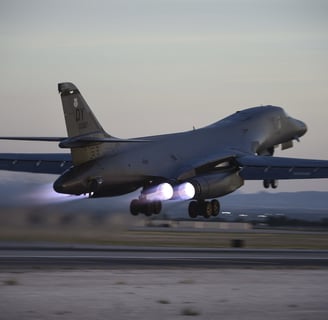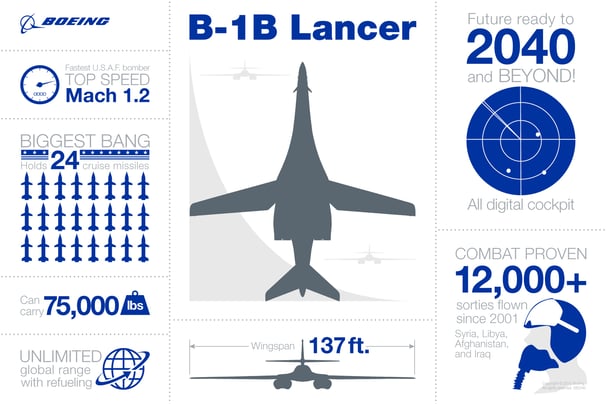Death from Above
Introducing the Rockwell B-1 Lancer Bomber
THE DARK SIDE


Background
In 2004, the Californian heavy metal quartet, System of a Down, sang "Where are we supposed to go when the bombs fall? ". One May evening 5 years later, a farming community in Farah Province Afghanistan found themselves asking the same question.
The B-1 Lancer bomber aircraft (pictured above), also known as the B-1B or "The Bone", is a formidable military asset that has been a vital part of the United States Air Force since the 1980s. Designed to deliver a wide range of conventional as well as nuclear weapons, this supersonic bomber has played a crucial role in various military operations around the world.
Advanced avionics and radar systems provide the crew with real-time situational awareness and enhance the aircraft's ability to operate in complex and hostile environments. In terms of its weapons capabilities, the B-1 Lancer is capable of carrying a significant payload of both guided and unguided munitions. It can carry twenty-four 2,000-pound bombs, as well as a variety of air-to-surface missiles and other precision-guided weapons. With an almost god-like ability to smite foes from altitude, the Lancer could only be created and operated by a world superpower.
That sounds expensive
It is. The power and capabilities of the B-1 Lancer come at a cost, and they are not insignificant. The procurement and maintenance of the aircraft, as well as the training of the aircrew, require significant financial resources.
The high-tech bomber's unit cost is $317 million, and to date, over 100 B-1s have been built.
Repair and maintenance costs are similarly high, a typical 12-hour operation brings total cost (not including pilots and payload) to be over one million dollars.
The B-1 has been used in numerous conflicts and operations, including the Gulf War, Kosovo War, Syria, Iraq, Afghanistan and more recently, the fight against Isis. While the high-tech aircraft is a genuine projection of military power and wealth, its abilities have almost exclusively been used against the poorer people of the world. Boeing testifies that Lancers have been used in over 12,000 missions in Syria, Libya, Afghanistan and Iraq.


The story
On May 4th 2009, a B-1 Lancer bomber carried out an airstrike on the village of Granai, in Western Afghanistan.
The first bomb struck the village mosque, where the residents had just completed evening prayers. Some ran to their homes but most of the people fled to the far side of the village where they assembled inside a compound. The B-1 Lancer's advanced systems detected the heat signatures of the crowd and the crew deployed another 2000 lb guided bomb into the centre of the gathering.
The aftermath of the airstrike on Granai was devastating. The Afghan government claimed that 140 civilians had been killed, including 93 children, a figure disputed by the US. The truth is, we'll never know.
Guy Smallman was the first western journalist to arrive on the scene. He counted "at least 70 graves" although he also pointed out that many of the graves contained entire families and noted one long trench which had been used to bury the body parts of unidentifiable individuals.
An early probe by the US military said that 20–30 civilians were killed along with 60–65 insurgents. The US admitted that significant errors had been made, including reliance on equipment "without the ability to discern the presence of civilians".
Peter Graff, reporting for Reuters in May 2009, said that the US had claimed,
"the Taliban were to blame for deliberately putting villagers in harm's way to create outrage over civilian deaths... According to the military's version of events, many of the dead may have been fighters, and some civilians may have been killed by militants throwing grenades, rather than by air strikes".
The repercussions
In response to mounting pressure, both the Afghan and international forces launched investigations into the incident. The findings revealed a series of failures and mistakes that contributed to the tragic outcome. It was discovered that the intelligence provided to the bomber aircraft was flawed, leading to the misidentification of the gathering as a group of Taliban insurgents. Additionally, there were breakdowns in communication among the various units involved in the operation, resulting in a lack of coordination and an inability to verify the target.
Sadly, the pressure to find justice gave way to arguments from both sides regarding the accuracy of the death toll.
In the end, the Afghan Government paid a total of $290,000 to relatives of the 140 victims.
Which is less than 1% of the unit cost of a B-1 Lancer bomber.


Infographic from boeing.com
